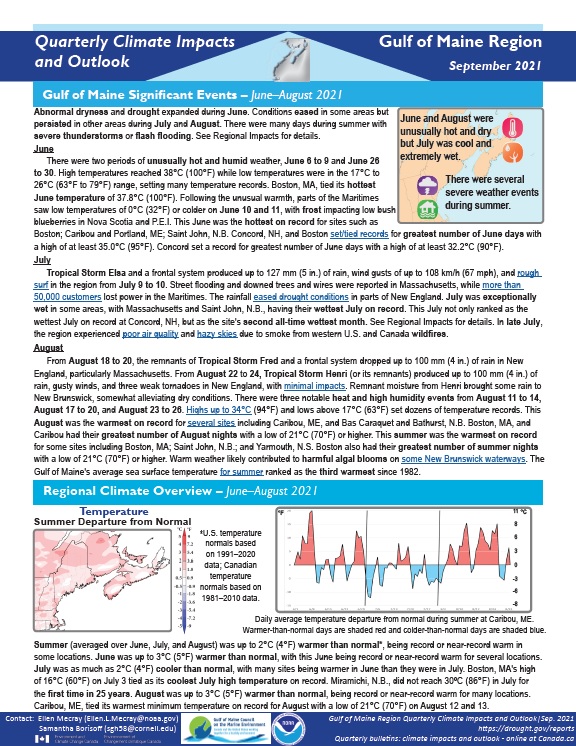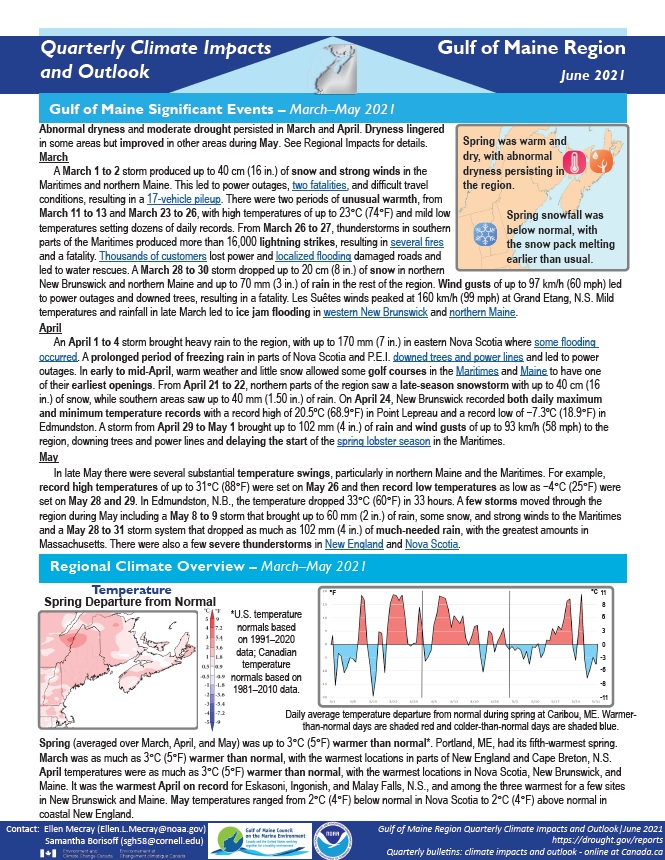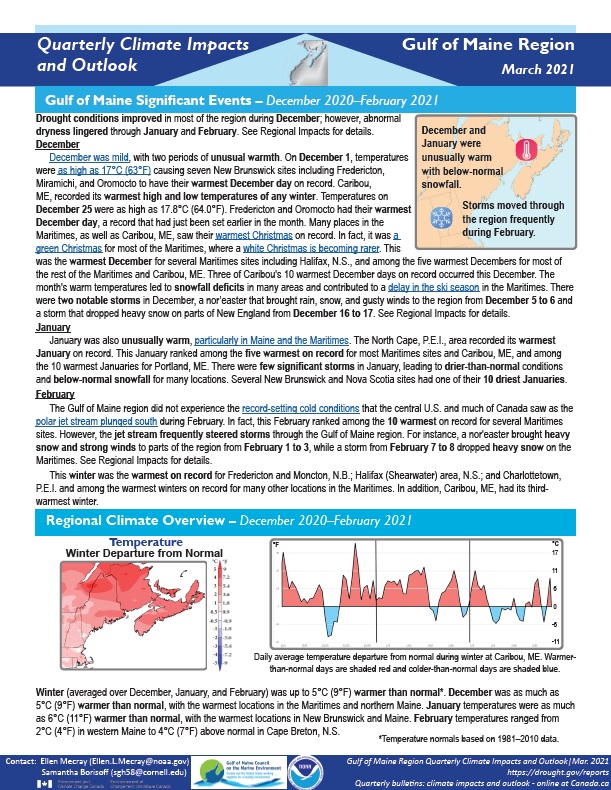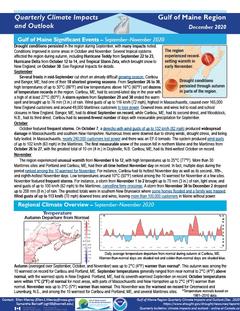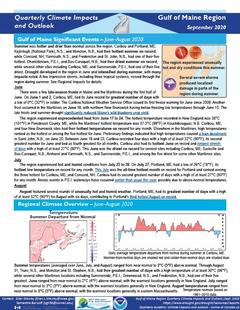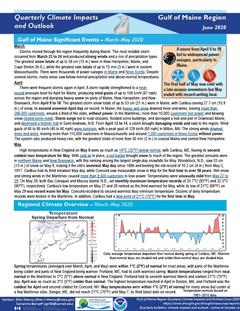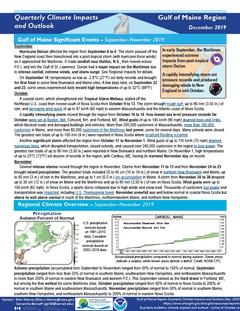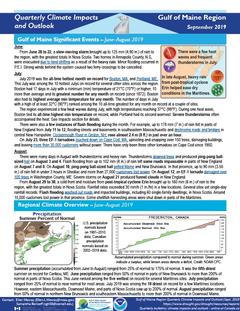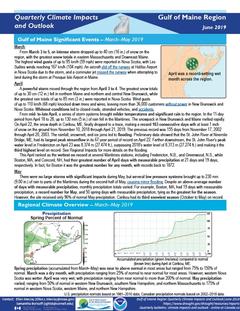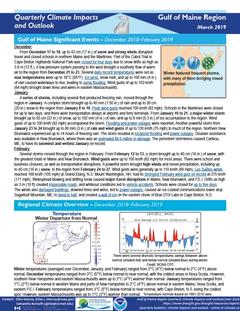Quarterly Climate Impacts and Outlook for the Gulf of Maine Region for March - May 2021. Dated June 2021.
Summer was up to 2°C (4°F) warmer than normal, being record or near-record warm in some locations. Summer precipitation ranged from 50% of normal to 200% of normal.
Quarterly Climate Impacts and Outlook for the Gulf of Maine Region for March - May 2021. Dated June 2021.
Spring was up to 3°C (5°F) warmer than normal in the region. Spring precipitation ranged from 50% of normal to 150% of normal. Sea surface temperature (SST) anomalies over the entire Gulf of Maine and Bay of Fundy were strongly above normal (greater than 2°C [4°F]) for the spring season. Anomalies were only slightly weaker around Cape Cod (around 1.5°C [3°F]) and over the Scotian Shelf (around 1.0°C [2°F]).
Quarterly Climate Impacts and Outlook for the Gulf of Maine Region for December 2020 – February 2021. Dated March 2021.
Winter was up to 5°C (9°F) warmer than normal. Winter precipitation ranged from 50% of normal to 150% of normal. Sea surface temperatures over the entire Gulf of Maine were strongly above normal for the winter season.
Quarterly Climate Impacts and Outlook for the Gulf of Maine Region for September – November 2020. Dated December 2020.
Autumn was up to 2°C (4°F) warmer than normal. This autumn was among the 10 warmest on record for Caribou and Portland, ME. Autumn precipitation ranged from 50% of normal to near normal for a majority of the region.
Quarterly Climate Impacts and Outlook for the Gulf of Maine Region for June – August 2020. Dated September 2020.
Summer was hotter and drier than normal across the region. Caribou and Portland, ME; Kejimkujik (National Park), N.S.; and Moncton, N.B., had their hottest summer on record, while Concord, NH; Yarmouth, N.S.; and Fredericton and St. John, N.B., had one of their five hottest. Charlottetown, P.E.I., and Bas-Caraquet, N.B., had their driest summer on record, while several other sites including Caribou, ME, and Summerside, P.E.I., had one of their five driest.
Quarterly Climate Impacts and Outlook for the Gulf of Maine Region for March – May 2020. Dated June 2020.
Spring temperatures (averaged over March, April, and May) were within 1°C (2°F) of normal for most areas, with parts of the Maritimes being colder and parts of New England being warmer. Spring precipitation (accumulated from March to May) ranged from 50% of normal to 110% of normal for much of the region.
Quarterly Climate Impacts and Outlook for the Gulf of Maine Region for September – November 2019. Dated December 2019.
Autumn temperatures (averaged over September, October, and November) ranged from 2°C (4°F) below normal to near normal in most areas, with eastern Massachusetts up to 1°C (2°F) above normal. Autumn precipitation (accumulated from September to November) ranged from 50% of normal to 150% of normal.
Quarterly Climate Impacts and Outlook for the Gulf of Maine Region for June – August 2019. Dated September 2019.
Summer temperatures (averaged over June, July, and August) were up to 2°C (4°F) above normal for most of the region. Summer precipitation (accumulated from June to August) ranged from 25% of normal to 175% of normal.
Quarterly Climate Impacts and Outlook for the Gulf of Maine Region for March – May 2019. Dated June 2019.
Spring temperatures (averaged over March, April, and May) were as much as 3°C (5°F) below normal. Spring precipitation (accumulated from March–May) was near to above normal in most areas but ranged from 75% to 150% of normal.
Quarterly Climate Impacts and Outlook for the Gulf of Maine Region for December 2018 – February 2019. Dated March 2019.
Winter temperatures (averaged over December, January, and February) ranged from 2°C (4°F) below normal to 2°C (4°F) above normal. Winter precipitation (accumulated from December–February) generally ranged from 75% to 150% of normal.


